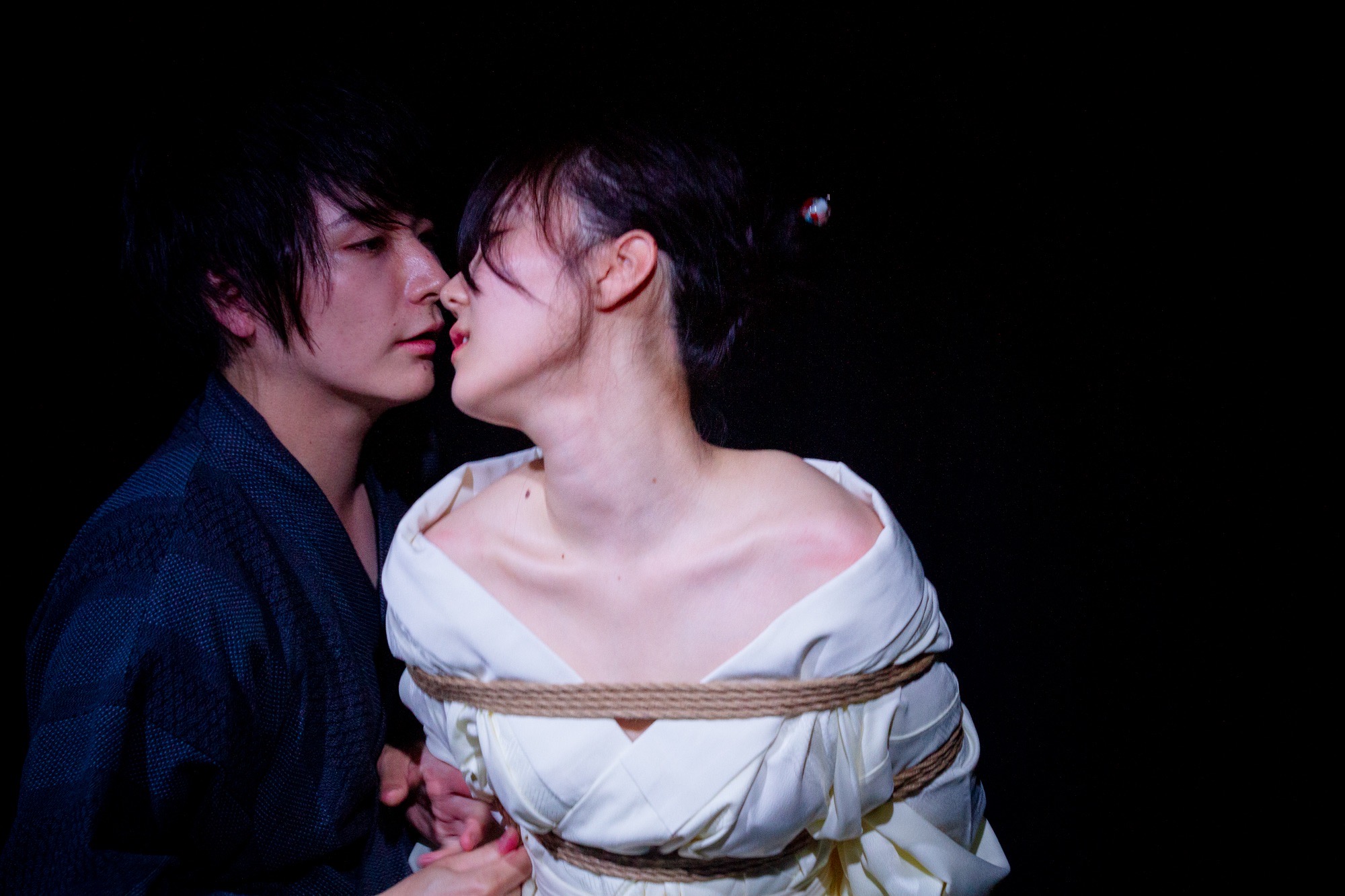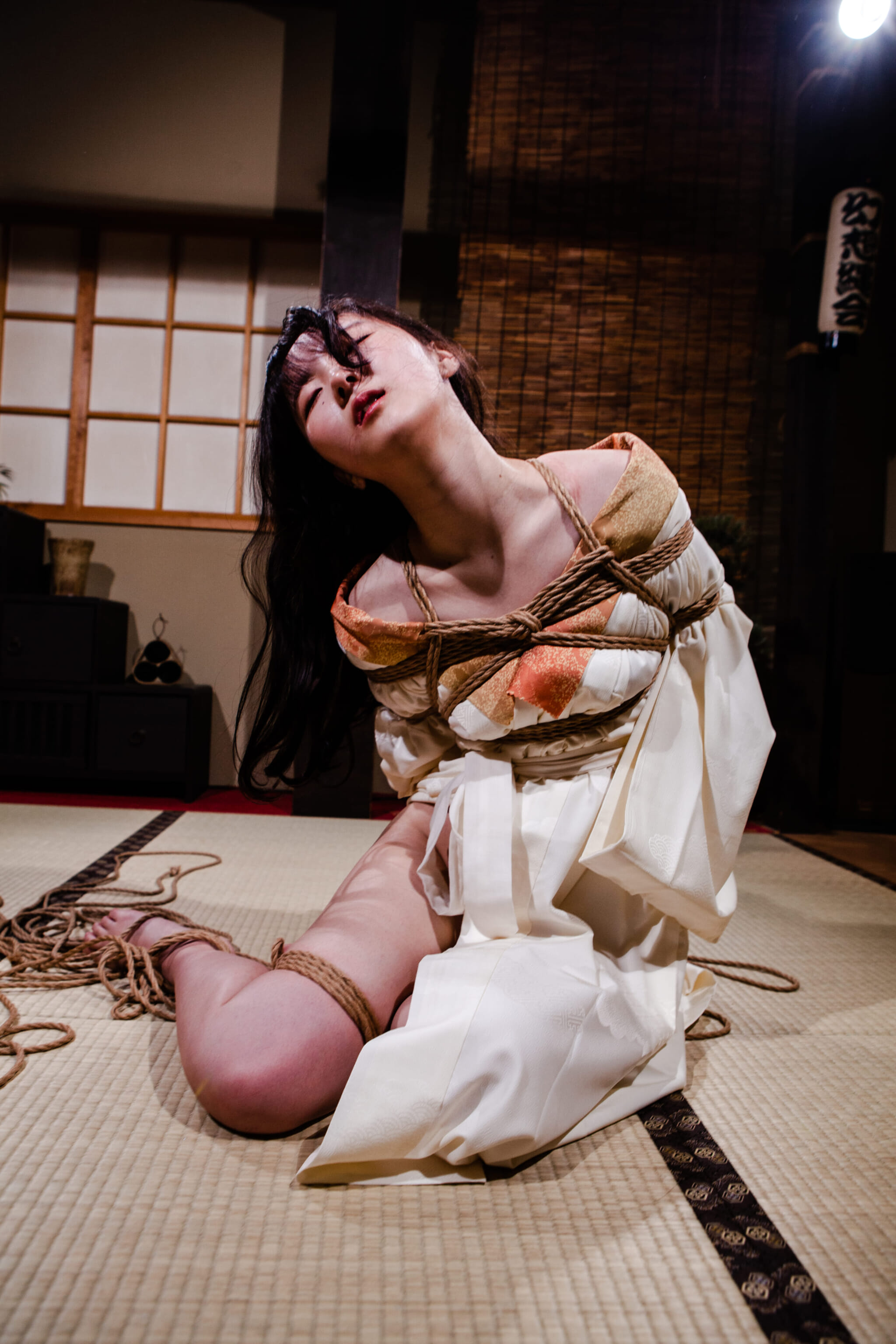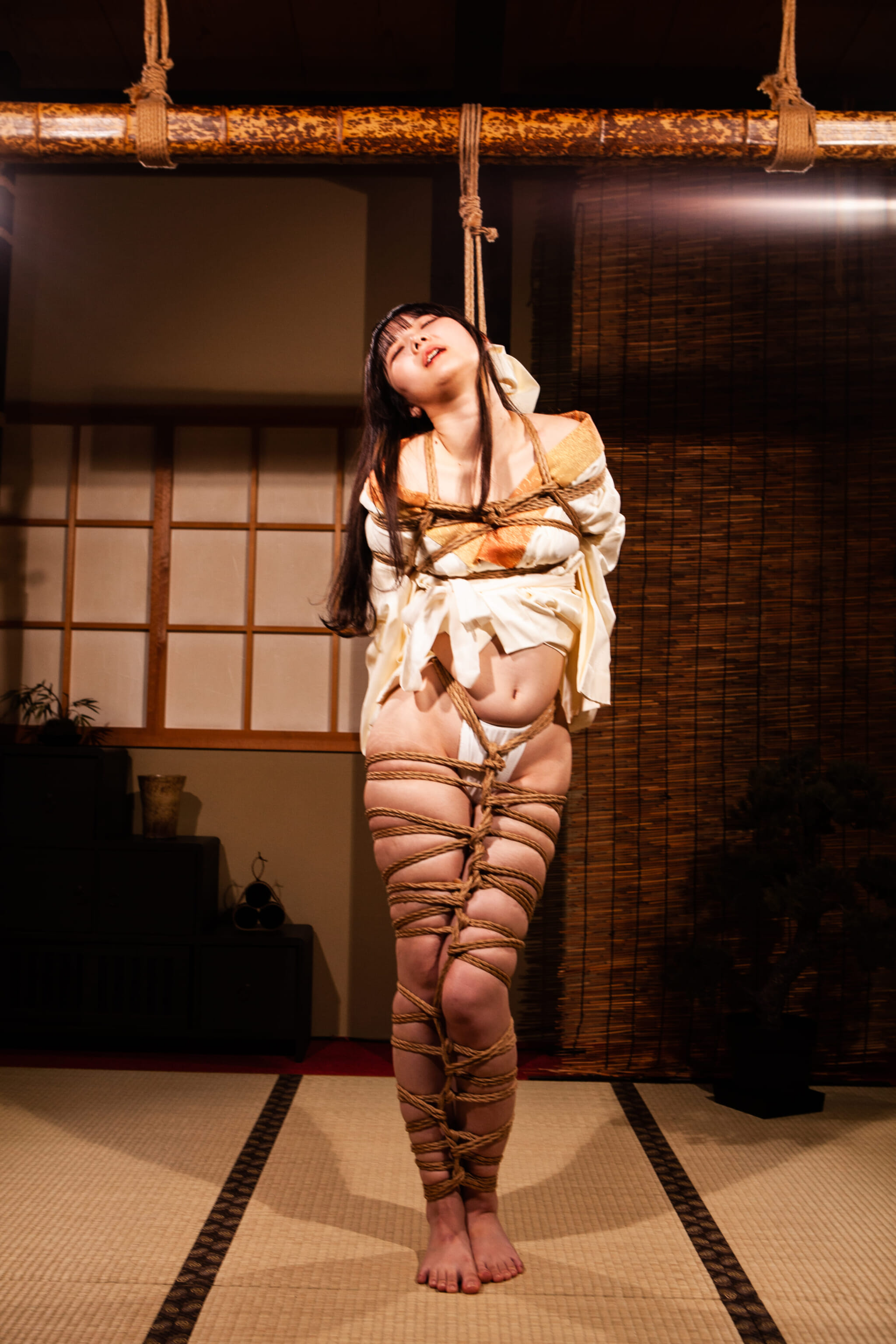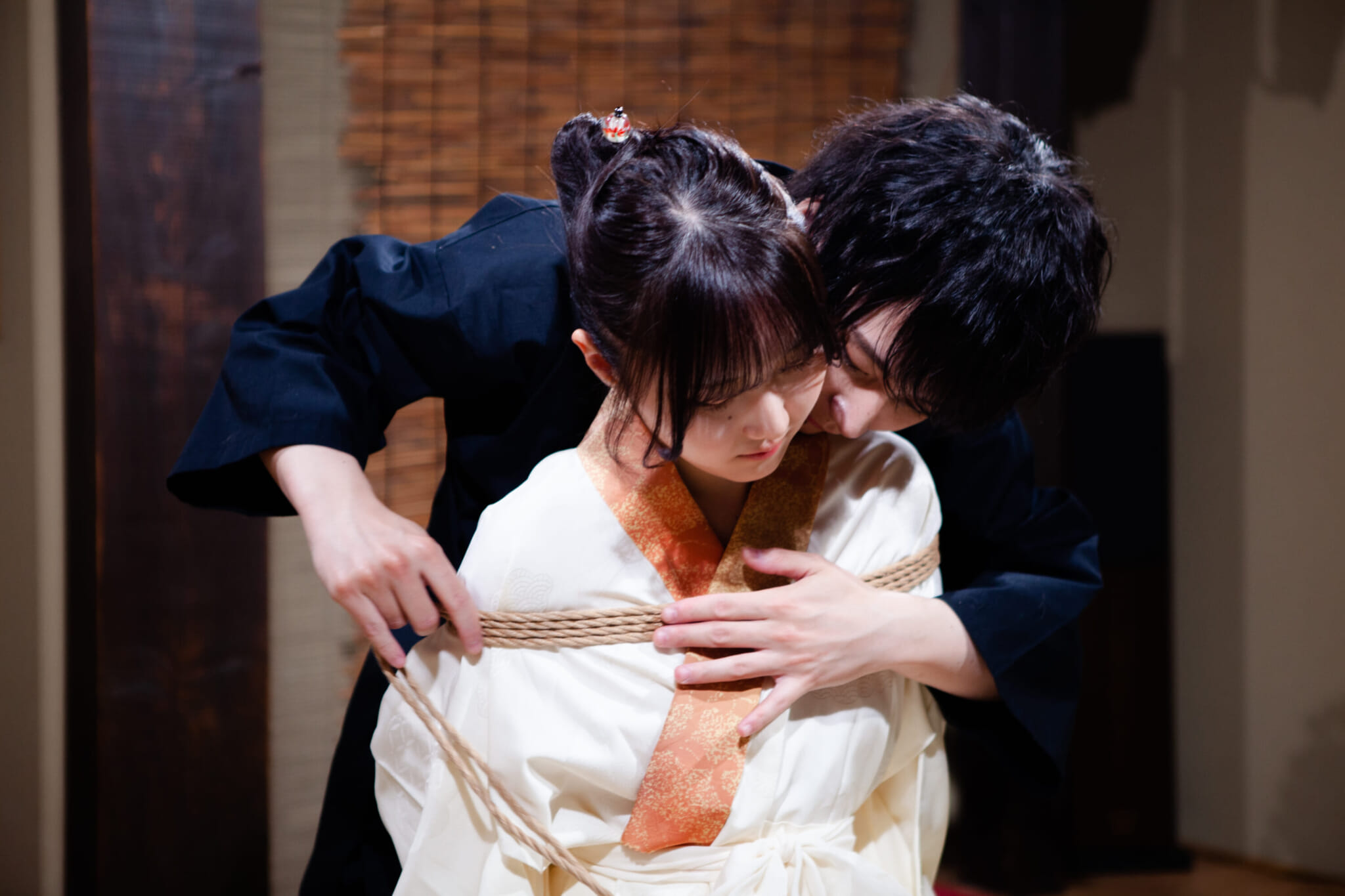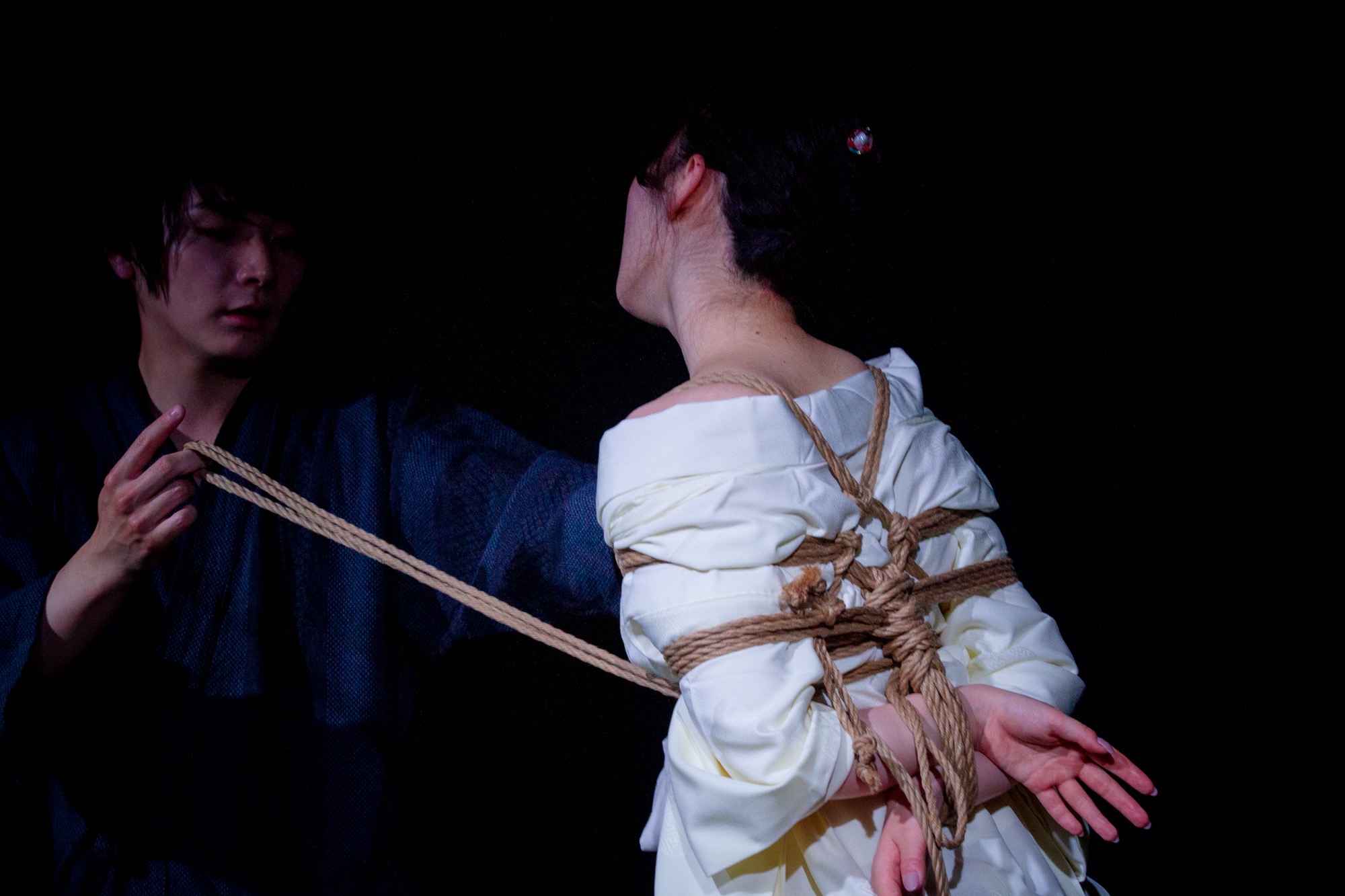Kinbaku, or Japanese rope bondage, is a form of consensual, sensual play that involves the meticulous binding of the body. It ranges from intimate floor techniques to full-body suspensions. At first glance, it appears as though it is a form of restraint. Quite often enthusiasts will refer to kinbaku as a form of interplay, which has a wide range of interpretations depending on the practitioner, called nawashi or bakushi, and their partner. For some, it is stimulating and titillating, while others find it relaxing and meditative.
Within the Japanese cultural context, shibari exists as a form of erotic play spawning from the country’s long history and multi-layered relationship with rope.
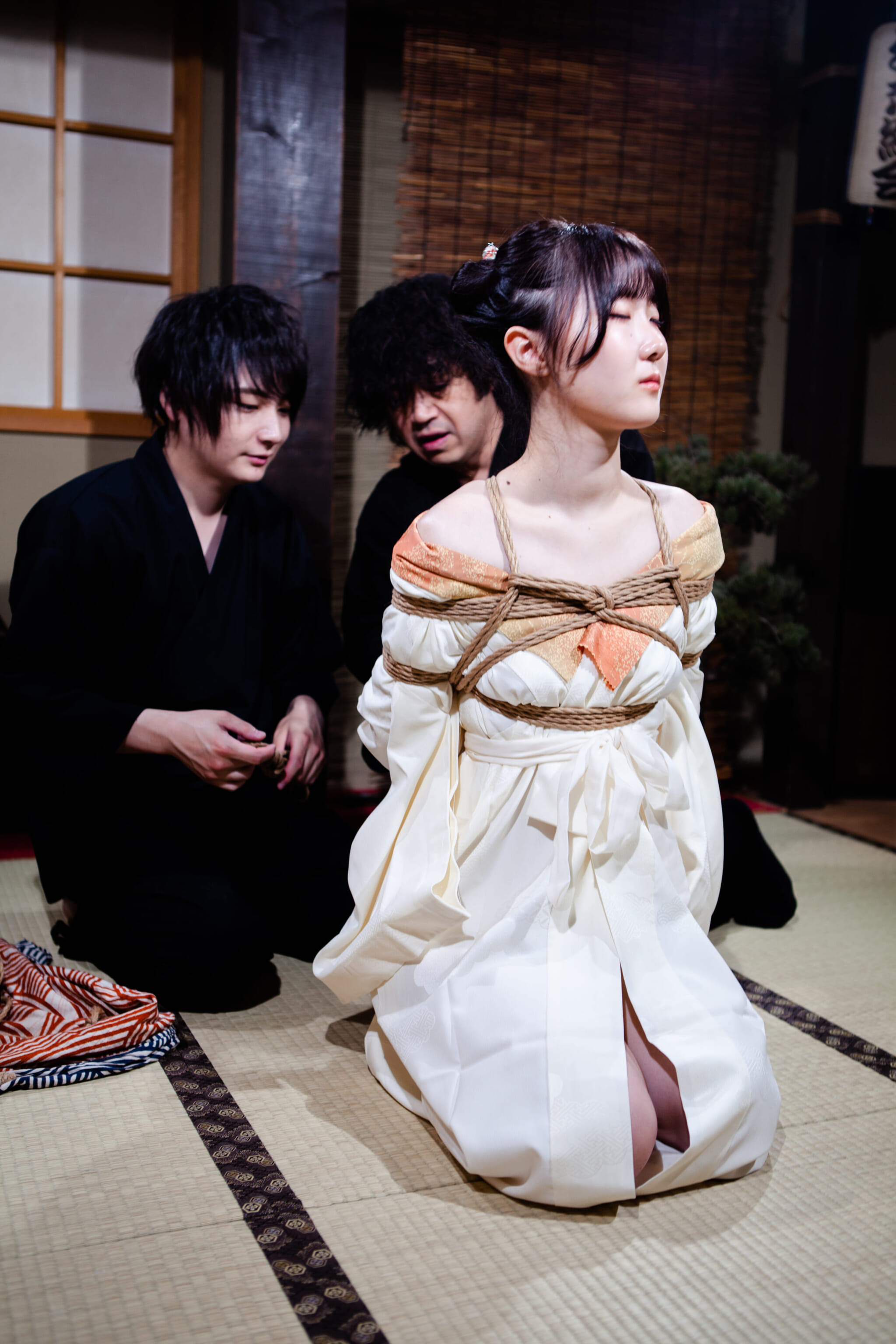
Tenma Haru and his apprentice Sora in the Gensonawa studio | Photo by Ronin de Goede
Hojojutsu was used on criminals during the Sengoku period (1477-1573) as a form of disciplinary restraint. During the Edo era (1603-1867), woodblock prints and kabuki scenes depicting rope torture spread these scenes of punishment and power into the public consciousness. Simultaneously, rope indicates something that is sanctified within the Shinto faith and is used not only at shrines but around sumo rings and natural effigies. Whether practitioners of kinbaku or shibari are consciously thinking of symbolism is questionable, but the propensity of rope as a signifier within Japanese culture lends itself to the cultural proximity people have to rope.
Contemporary kinbaku culture was made into a form of entertainment, as opposed to medieval torture, starting with artist Seiu Ito, who expressed kinbaku as a form of art. In post-war Japan, videos, shows and magazines on the subject flourished. Writers and editors were bakushi themselves, a connection that continues today.
The job of a nawashi is varied and ranges from lessons and pornography to shows and sessions. Most famous nawashi have their own communities which function as geeky, but friendly social spaces. And lately, the internet makes it easier for women enthusiasts to explore. There is a propensity for them to seek services rather than the other way around.
Midori’s Seductive Art of Japanese Bondage
Kinbaku has been steadily and explosively taken up with a high level of gusto, mostly in Europe and North America with a constant barrage of workshops, festivals and conventions solely for shibari. Prior to the early 1950s, the term “shibari” was used in Japan, but recently the term “kinbaku” is more common to refer to Japanese bondage. “Shibari” is more often used as a verb form (meaning “to bind”). In the West, however, “shibari” is used as a noun.
Midori, author of the seminal book on kinbaku, Seductive Art of Japanese Bondage, is a Japanese American sex educator who was born in Japan and moved to the US when she was 14. A prominent figure in sex advocacy, activism and instruction, her work ranges from teaching therapists how to deal with patients with kink-orientated leanings, to lecturing on fundamental topics such as consent and negotiation to a Japanese audience. Midori’s aforementioned book, published in English, was instrumental in introducing shibari to audiences abroad.
“My play is about collaborative joy-making,” Midori tells Tokyo Weekender. “The conversation is about what will delight us both, it is not about compromise. I am co-creating joy and delight in whatever form that takes. People often engage in kink here as a way to discover themselves, or to have a cathartic moment, to feel connected, or to feel the thrill of transgression.”
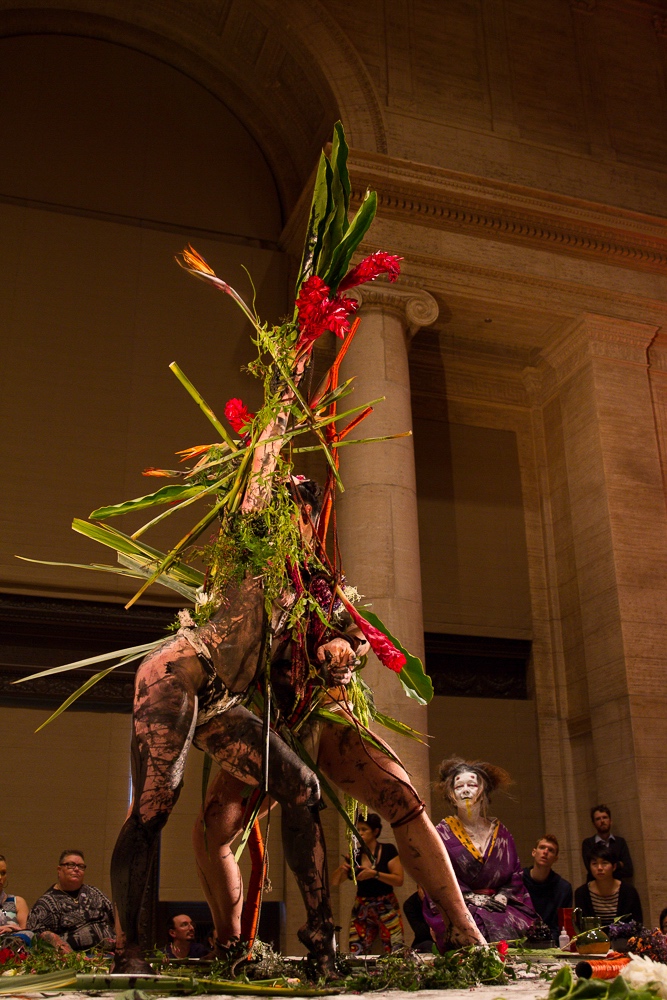
Midori’s artistic performance at the Asian Art Museum in San Francisco, 2014
Despite kinbaku being an underground pursuit in Japan, with events usually taking place in strip theatres and subterranean SM bars and clubs, Midori often headlines at conferences with over 1,500 attendees.
She explains that kinbaku in North America takes place in a social context and background where the various liberation movements such as the civil rights and LGBTQ movements in the 1960s took place along with those related to racial minorities. Simultaneously, the advent of reproductive technologies meant that “the sexual strategies for experimentation were made a lot easier.”
Midori adds, while there is an element of orientalism, like “I want to be a submissive geisha girl slave” (a comment she says with a large dollop of cringe), there is also an active conversation about cultural appropriation of what is ostensibly meant to be Japanese culture.
Alexander Ma’s Kinbaku Society
Kinbaku has resonated with people from all over the world and has something like a cult following in Europe. Alexander Ma is a practitioner in Berlin, taking classes from nawashi, Akira Naka. He publishes a limited-edition collectible magazine called Kinbaku Society in order to further his understanding of Japanese culture. He first saw shibari via Nobuyoshi Araki’s photos in the 1990s and at shows where a harness was bound around a model, which he admits “looked incredibly boring.” It wasn’t until 2007 when he saw a show he felt was “emotional and poetic” that he garnered a real interest in kinbaku.
Coming from a BDSM background, Ma says, “Today, shibari is becoming increasingly popular in Europe, but not as erotic play. Shibari equals sensual bodywork, at best to some ‘conscious sexuality.’ The most typical line is: ‘Shibari is an ancient art form, practiced in Japan.'” He adds that the liberation ignited by the 1960s and ’70s sexual revolution is “coming to an end and getting rolled back” instigated by an “increasingly conservative religious movement.”
“Over the past seven to eight years, shibari has grown extremely popular, which has led to an immense influx of young people,” says Ma. He adds that in some cases, they are around half the age of those who originally brought kinbaku to the West and often come across it at events or festivals. “They practice shibari in the context of sensual, conscious bodywork. They are also the ones who — as digital natives — study with online courses and self-organized classes.”
One such online class is Shibari Study, based out of Germany. According to director Enna Nguyen, one of their most popular online classes is the semenawa class, which has more intense ties. However, she says, “As the practice grows, we’re witnessing the beginning of some cultural separation of shibari from sex.”
Ngyuen mentions that whether intentional or not, there is a mental benefit from shibari that has parallels with other mindfulness practices such as “being present in the moment, paying attention to breathing to work through moments of either physical or psychological intensity, listening to your body, and recognizing and clearly communicating your needs and intentions.”
Ranki Kazami: An International Bakushi
Ranki Kazami is an Osaka and Tokyo-based bakushi who is active internationally, running two official schools in Canada and Australia, both managed by his apprentices. He often goes overseas for a month at a time, going from city to city. He started his forays into BDSM after meeting girls via telephone meet-up services (think Tinder without the photos, where meetings happen after a multi-hour phone call with a potential partner), after which he initiated a community for enthusiasts around 1996.
Kazami started to host workshops and perform overseas in 2001 when he was invited to the London Rope Festival, a festival for shibari fans. He observes that around this time, BDSM and kinbaku started to be treated as separate entities. Kazami was often asked to demonstrate just the technical aspects of kinbaku and only show erotic and BDSM elements at closed-door events.
Kazami has a license system, giving permission to teach to those he feels have a level of competence and originality. Should he want to take on another apprentice, Kazami would also require the agreement of the other apprentices, as he doesn’t want members of “his family” to fight with one another. He consciously spreads them out geographically. However, he doesn’t have any Japanese apprentices. This is, in fact, a phenomenon that is common among famous nawashi.
“It is quite hard to breed new talent in Japan,” he says. “It is easier to do it overseas. I think it can’t be helped. In Japan, it is a sexual activity, so it is underground, whereas overseas it is seen as culture. Also, with the nawashi, they want to leave behind their form, they worry that it won’t be left behind properly or there are some students that are using it just to make money. If I do it in Japan, I would like to do it together with other people.”
A Bondage Event with Sora
Visiting a bondage event at Mirage, an SM club in Kinshicho, on a Sunday afternoon and, surprisingly, the venue is overflowing with young females. They are mostly there to see Sora, an apprentice in his 20s who is active on the show circuit and is also a service provider, going from one female client to another, all day, almost every day except for the days he works at his master’s salon in Yokohama. Sora is seen as a bit of an anomaly in terms of his skill, given his age. He is one of the few young prospects in the country. It took him a year to become Haru Tenma’s apprentice, after attending his classes twice a week for three months, then private classes once a week thereafter.
“It takes time, and you can’t do anything at the beginning,” Sora says. “I think there aren’t that many that can aim to do it professionally. Even though I am competitive by nature, I don’t have that many peers my age. However, I can compare myself with the person I was before and aim to improve. I can recognize when the audience is touched at shows because they are crying, and I aim to make an even more moving show the next time.”
Sora’s clients are predominantly new to kinbaku, so his work emphasizes safety while trying to create a pleasurable and intimate erotic experience via rope. “It is play where you stimulate the mind, you excite and play with the brain. By limiting what they can do, I can control females in a way that I can understand. I can raise their concentration and sensitivity. I am observing the girl and I adjust the rope accordingly and am considering their perspective.”
Tenma, Sora’s master, says of his generation, “I have a lot of senpai, but they don’t have apprentices. It was called the ‘blank generation.’ There are so few around me and I was called a ‘newbie’ for 10 years because the next generation didn’t appear. The people above me were prioritizing shows and active duties rather than making apprentices.
“There is this Japanese culture, so I want to continue that,” he adds. “There are a lot of people going overseas to teach, and that is important, but for me, I think we should be teaching Japanese too. It is like sumo; all the strong people will be from overseas.”
Updated On April 27, 2023

